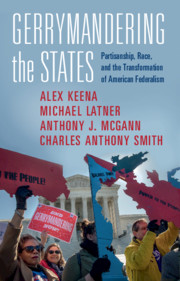Book contents
- Gerrymandering the States
- Gerrymandering the States
- Copyright page
- Contents
- Figures
- Tables
- Acknowledgments
- 1 Redistricting Wars in the US States
- 2 What Happened in 2011? The Other “Great Gerrymander”
- 3 When Politicians Draw the Maps
- 4 How Political Geography Affects Bias
- 5 Racial Geography, the Voting Rights Act, and Bias
- 6 The Policy and Social Consequences of State Legislative Gerrymandering
- 7 The Democratic Harms of Gerrymandering
- 8 When the Courts Redistrict
- 9 How to Design Effective Anti-gerrymandering Reforms
- Conclusion
- References
- Index
3 - When Politicians Draw the Maps
Published online by Cambridge University Press: 02 July 2021
- Gerrymandering the States
- Gerrymandering the States
- Copyright page
- Contents
- Figures
- Tables
- Acknowledgments
- 1 Redistricting Wars in the US States
- 2 What Happened in 2011? The Other “Great Gerrymander”
- 3 When Politicians Draw the Maps
- 4 How Political Geography Affects Bias
- 5 Racial Geography, the Voting Rights Act, and Bias
- 6 The Policy and Social Consequences of State Legislative Gerrymandering
- 7 The Democratic Harms of Gerrymandering
- 8 When the Courts Redistrict
- 9 How to Design Effective Anti-gerrymandering Reforms
- Conclusion
- References
- Index
Summary
We investigate the role of politics in determining whether a map is drawn with partisan bias. We take a systematic look at the processes that states use to regulate the drawing of the lines through case studies and empirical analyses of redistricting outcomes, paying particular attention to one key variable: whether the maps were drawn by politicians. We find that the most biased maps occur in competitive states where politicians from a single party were able to draw the maps without having to work with the minority party. Our examination of the effects of bipartisan districting yields inconclusive results. In some cases, when the redistricting process requires two parties to work together to pass a plan, redistricting authorities draw the maps with low levels of seat–vote responsiveness, presumably as a result of the drawing of “safe seats” to benefit incumbents from both parties. However, in other cases, we do not see this outcome. We do find that, on average, bipartisan districting leads to a preservation of the status quo. In the states where two parties worked together to draw the maps, the level of bias in the post-2011 plans deviated little from the pre-2011 plans.
- Type
- Chapter
- Information
- Gerrymandering the StatesPartisanship, Race, and the Transformation of American Federalism, pp. 50 - 78Publisher: Cambridge University PressPrint publication year: 2021



